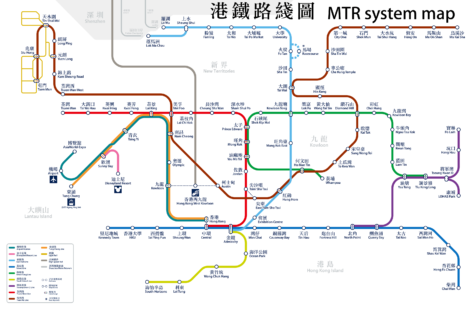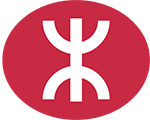Hong Kong Mass Transit Railway, locally known as 港鐵 (MTR), operates in the Hong Kong Special Administrative Region.
This metro system was inaugurated on 1 October 1979, covering 174.7 km (108.6 miles) of roads and counting on 95 stations and 11 main lines. Transports more than five million passengers daily, offering reliable and punctual service.
subway map
Below we show you the Hong Kong subway map. Click on the image to see it larger:

The same Hong Kong subway map in PDF format.
Official Web site
- Visit the official MTR website for more information: MTR Hong Kong.
- On this other website you can see some Hong Kong attractions that have discounts.
Hong Kong subway timetables
The Hong Kong MTR has slightly different schedules on weekdays and on weekends or holidays. Next, the hours of operation are detailed:
| Line | Weekday schedule | weekend schedule |
|---|---|---|
| Island Line | 05:50 – 01:21 | 06:00 – 01:00 |
| Tsuen Wan Line | 06:00 – 01:00 | 06:00 – 01:00 |
| Kwun Tong Line | 05:50 – 00:59 | 06:00 – 01:00 |
| Tseung Kwan O Line | 05:30 – 00:59 | 06:00 – 01:00 |
| South Island Line | 06:00 – 01:00 | 06:00 – 01:00 |
| Tung Chung Line | 05:48 – 00:52 | 06:00 – 01:00 |
| Tuen Ma Line | 05:45 – 00:59 | 06:00 – 01:00 |
| East Rail Line | 05:30 – 00:59 | 06:00 – 01:00 |
| Airport Express | 05:54 – 00:48 | 06:00 – 01:00 |
In special occasions, like New Year or important events, MTR extends service hours to accommodate additional passengers.
Hong Kong Subway Prices
| Type of ticket | Price in HKD | Price in USD |
|---|---|---|
| One-way ticket | 10-25 HKD | 1.28-3.20 USD |
| Round trip ticket to the airport | 55-105 HKD | 7.05-13.46 USD |
| Card Octopus (Adult) | 10-25 HKD | 1.28-3.20 USD |
| Card Octopus (Niño) | 5-12.5 HKD | 0.64-1.60 USD |
| Tourist Card (1 day) | 65 HKD | 8.32 USD |
Card Octopus: A reloadable card that offers fare discounts and can be used at stores and restaurants. It is the most convenient option for residents and is also available for tourists.
Tourist Card (1 day): This card allows unlimited travel on the MTR during 24 hours from first use. Cuesta 65 HKD (about 8.32 USD) and is ideal for tourists who plan to explore the city intensively in a single day.
Round trip ticket to the airport: Offers a round trip between the airport and any MTR station for a price of 55-105 HKD (7.05-13.46 USD), depending on the distance.
History of the subway
Twentieth century

The idea of building a rapid transportation system in Hong Kong arose in the years 60 due to rapid population growth. In 1966, the British government commissioned transport consultants Freeman, Fox, Wilbur Smith & Associates a feasibility study. In 1967, presented the “Hong Kong Mass Transportation Study”, which recommended the construction of a system of 40 miles (64 km) fast train in six stages, with an expected completion between 1973 y 1984.
The 1 October 1979, the first MTR line was inaugurated, the Kwun Tong Line, what was about Kwun Tong a Shek Kip Mei. This first section had only 15 kilometres, but it was very popular. Shortly after, The line was extended south to include Tsim Sha Tsui station..
In 1980, the port's underground connection was opened, joining the Tsuen Wan line with the Central station. This marked a significant change in the city's public transportation.. Five years later, in 1985, was inaugurated Island Line, that connected Central with Chai Wan, covering the northern coast of Hong Kong Island.
During the years 90, the MTR system continued its expansion. In 1997, with the transfer of sovereignty of Hong Kong from Great Britain to China, the line Island spread to the eastern districts of Hong Kong Island. Besides, the card was inserted Octopus, that revolutionized the payment system, allowing passengers to travel throughout the MTR network and pay for other services such as shops and restaurants.
XXI century
In 2007, the MTR merged with the Railway Kowloon-Canton (KCR), consolidating your network and further expanding your reach. In 2018, high-speed rail link was inaugurated Guangzhou-Shenzhen-Hong Kong, allowing quick travel between Hong Kong and major cities in mainland China.
The MTR has implemented various technological innovations, like platform doors, real-time information systems and automatic fare collection systems. These improvements have increased the convenience, safety and efficiency for passengers.
Hong Kong Subway Map History
The design of the Hong Kong subway map has evolved significantly since its creation. On the first years, the priority was basic functionality, but over time it has become an essential tool for urban navigation.
Origins and first designs
In the decade of 1970, when the MTR began its operations, The maps were simple and rudimentary. The first map, created in 1979, showed only the line Kwun Tong, what was about Shek Kip Mei a Kwun Tong. This design was influenced by the subway maps of London y New York, prioritizing clarity over precise geography.
decade of 1980 and expansion
During the years 80, The map was expanded to include new lines such as the Tsuen Wan Line and the Island Line. The designs became more sophisticated with the incorporation of distinctive colors for each line, facilitating quick and easy identification of routes. In 1985, the introduction of the Island Line brought with it a significant redesign of the map to accommodate the new infrastructure.
Innovation in design
In the years 90, the MTR hired the design company Cartlidge Levene, based in London, to redesign the map. This team introduced a more modern and clean style, that has remained until today. The maps began to include more details about connections and points of interest near the stations, improving user experience.
Digital implementation
With the advancement of technology, the MTR has also adopted digital tools. In 2007, the first interactive online map was launched, allowing users to plan their trips more accurately. The implementation of mobile applications and interactive maps has made navigation even easier..
Adaptations and updates
The map has continued to evolve with the expansion of the network. Each new line or extension has required adjustments and redesigns. The opening of the high-speed line Guangzhou-Shenzhen-Hong Kong in 2018 and the future extension of the Tuen Ma line are examples of how the map continually adapts to the changing needs of the city.
Additional data
The MTR is not only an efficient means of transportation, but also an attraction for tourists. For example, The Disneyland Resort line connects visitors directly to the famous theme park.
Besides, Many MTR stations are located near major tourist spots such as Victoria Harbor, Tsim Sha Tsui, and the shopping areas of Mong Kok and Causeway Bay.
Below is the list of the main tourist attractions and how to get there by metro:
- Victoria Peak (Central, Tsuen Wan Line): Offers panoramic views of Hong Kong and Victoria Harbor. It is ideal for photography and hiking.
- Tian Tan Buddha (Tung Chung, Tung Chung Line): An impressive bronze Buddha 34 meters, accessible by Ngong Ping cable car 360.
- Hong Kong Disneyland (Disneyland Resort, Disneyland Resort Line): Theme park with exclusive areas like Mystic Point and Grizzly Gulch. Perfect for families.
- Temple Street Night Market (Jordan, Tsuen Wan Line): Night market, known for its food stalls, clothing and live entertainment.
- Avenue of Stars (Tsim Sha Tsui, Tsuen Wan Line): Boardwalk honoring Hong Kong's film industry. Stunning views of the skyline.
- Sky100 (Kowloon, Tung Chung Line): Viewpoint on the floor 100 del ICC, offers views of 360 city degrees. Ideal for watching the sunset.
- Ocean Park (Wong Chuk Hang, South Island Line): Theme park and aquarium, Known for its exciting attractions and marine life shows.
- Lan Kwai Fong (Central, Tsuen Wan Line): Famous nightlife district, with a wide variety of bars, restaurants and clubs. Popular with locals and tourists.